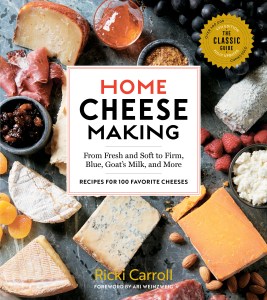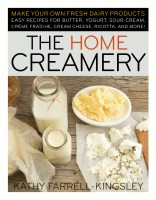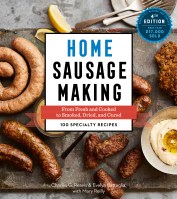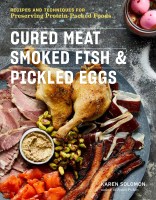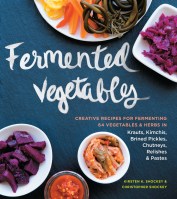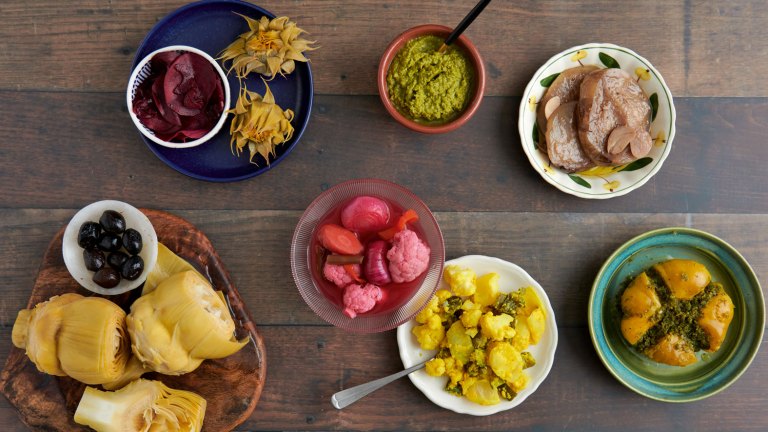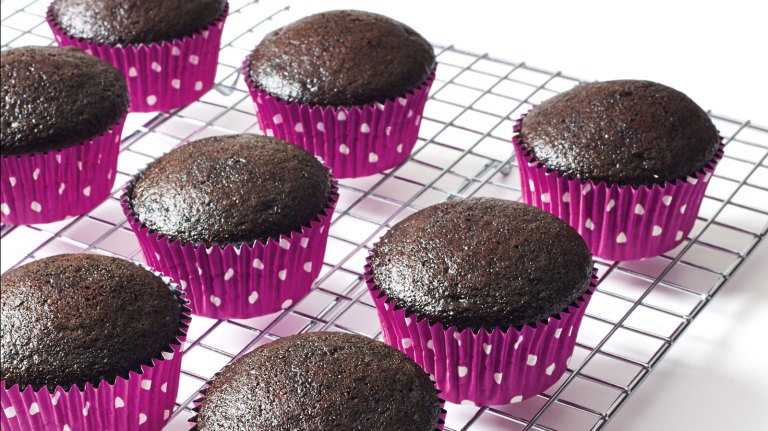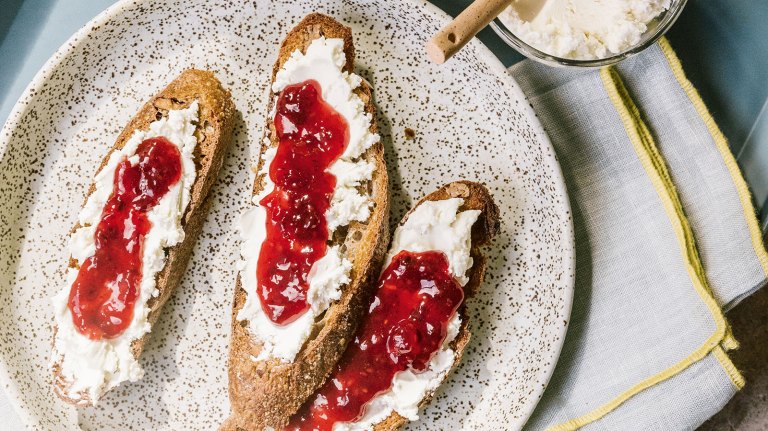Cinnamon Rolls with Crème Fraîche Glaze
You don’t have to be an experienced cheese maker to make your own crème fraîche — sour cream’s creamier, dreamier cousin and the secret ingredient in these must-make morning treats.

Many a home cheese maker started off with cultured dairy products such as butter, sour cream, yogurt, and crème fraîche. The methods used to produce them are simple and straightforward, and you can use almost any type of milk, including dried milk powder, low-fat milk, whole milk, light cream (25%), and half-and-half, as well as goat’s milk or sheep’s milk.
If you’ve always loved the rich, tangy taste of crème fraîche but not the usual high cost, here’s your answer: Make it yourself, and in very short order. It’s wonderful as is, dolloped over desserts or fruit (it has a particular affinity for grilled peaches and is even creamier when drained and used as a base for dips and spreads or stuffed into fresh figs or dried dates). It ups the scrumptious factor as a rich replacement for the usual milk in a glaze for topping off still-warm cinnamon rolls.
If you are buying cream at a store, look for light cream (typically 18–30% fat) or half-and-half (typically 10–18% fat). Whipping cream and heavy cream are frequently too high in butterfat to set properly. Try to avoid ultrapasteurized cream. For more on what it means when you see “ultrapasterurized” or “UP,” see the note that follows the recipes.
Crème Fraîche
Yield: About 1 pound
Ingredients
- 1 quart pasteurized light cream or half-and-half (25–40% butterfat)
- 1 packet crème fraiche starter culture [See note]
Directions
1. Heat the cream to 86°F (30°C).
Add the starter; cover and let the cream set undisturbed at room temperature (72°F/22°C) for 12 hours, or until coagulated.
It is now ready to use, and will keep for up to 1 week stored in the refrigerator.
Note:
You can find cultures for all types of cheese and other dairy products at cheese-making supply houses or online. They are most often in freeze-dried powdered form and can be stored in the freezer (unopened) for up to two years.
Cinnamon Rolls with Crème-Fraîche Glaze
An overnight rise in the refrigerator boosts the flavor of the rolls, but for more immediate cinnamon-roll satisfaction, proof the rolls on the counter for about 2 hours, or until doubled in bulk.
MAKES 1 DOZEN
Ingredients
FOR THE ROLLS
- 1 cup whole milk
- 2 eggs
- ½ cup granulated sugar
- 2 packages (¼ ounce each) or 2 tablespoons active dry yeast
- 1½ teaspoons kosher salt
- 3¾ cups all-purpose flour, plus more for dusting
- ½ cup whole-wheat flour
- 1 cup (2 sticks) unsalted butter, softened, plus more for baking pan
- 1 cup packed light brown sugar
- 3 tablespoons ground cinnamon
FOR THE GLAZE
- ½ cup crème fraîche, more if needed
- 1 cup confectioners’ sugar
- Pinch of kosher salt
Directions
Make the rolls: Beat the milk, eggs, granulated sugar, yeast, and salt in the bowl of a stand mixer with the paddle attachment on medium speed until combined. Beat in one-third of the all-purpose flour.
Switch to the dough hook. Add the remaining all-purpose flour and the wheat flour. Mix on medium-low speed until the dough comes together. Increase speed to medium-high and add half the butter, a few pieces at a time, and mix until fully incorporated.
Cover bowl and let the dough rise in a warm, draft-free place until doubled, 1½–2 hours.
Put the remaining butter, the brown sugar, and cinnamon in a medium bowl and stir with a flexible spatula until combined.
Transfer dough to a lightly floured work surface. Using your hands and a rolling pin, gently press and roll the dough into an 18-by-24-inch rectangle. Spread the butter mixture across the dough, leaving a 1-inch border around the edge. Roll the dough tightly up into an 18-inch-long log. Cut the log into 12 (1½-inch-thick) slices.
Grease a 9-by-13-inch baking pan. Nestle the rolls into the pan and cover the pan with plastic wrap. Let rolls rise in the refrigerator overnight until doubled. Remove from refrigerator and let rolls sit at room temperature for about 30 minutes.
While the rolls are resting, preheat the oven to 350°F (180°C). Bake the rolls for about 30 minutes, or until golden brown and cooked through. (If the rolls start to brown too quickly, cover loosely with foil and reduce heat to 325°F/170°C.) Remove from oven and let cool while making the glaze.
Make the glaze: Whisk the crème fraîche, confectioners’ sugar, and salt in a small bowl until smooth and combined. Add more crème fraiche as needed to reach the desired consistency. Spread over the warm rolls and serve.
A Note about “Ultrapasteurized”
Ultrapasteurized (UP) milk or cream has been heated to 280°F (138°C), which destroys all organisms. The purpose of some UP treatment is to give the product longer shelf life: UP milk and cream will last 90 days, or longer, unopened. (Once opened, they keep only as long as conventionally pasteurized milk and cream.) It has no real advantage for the consumer but is convenient for the processor, who can buy less milk and transport it farther. UP milk has a cooked taste, like evaporated milk. UP cream is even worse; it leaves a greasy film on coffee and is difficult to whip. Large processors market UP milk by pandering to people’s fears about food safety. Conventionally pasteurized milk and cream are sufficiently treated to deal with any possible pathogens. Unfortunately, to the dismay of home cheese makers (and consumers who simply like to drink milk), more and more of the milk and cream in grocery dairy cases is ultrapasteurized. Besides giving milk a less-than-desirable taste, the UP process damages the protein structure and destroys the enzymes of the milk so it is utterly useless for a lot of home cheese making. And to make matters worse, you may need to search hard for the small “UP” on the label. What’s a home cheese maker to do? Talk to your grocer and demand an alternative to UP milk and cream. Fresh, local ingredients will give your homemade cheeses and cultured dairy products the most complex flavors. Use them whenever possible
Excerpted from Home Cheese Making, 4th Edition © Ricki Carroll.
The completely updated fourth edition features 35 new cheese recipes, color photography of step-by-step techniques, and new profiles of contemporary cheese makers. The additions to this comprehensive volume reflect the broader selection of cheeses available in specialty food stores and groceries, including burrata, stracchino, Brillat-Savarin, D’Affinois, Cambrales, Drunk Gouda, Pecorino Pepato, goat milk’s gouda, and more. Companion recipes are included for cheese plate condiments and classic cheese dishes. For cheese lovers wanting to make their own, Ricki Carroll’s expert advice is the key to success.
